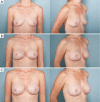Current strategies with 2-staged prosthetic breast reconstruction
- PMID: 26161305
- PMCID: PMC4461711
- DOI: 10.3978/j.issn.2227-684X.2015.04.22
Current strategies with 2-staged prosthetic breast reconstruction
Abstract
Over the last decade, prosthetic-based breast reconstruction has been revolutionized with technological advancements. Reconstructive surgeons now have a multitude of prosthetic devices and tissue expanders, tools for intraoperative perfusion analysis, implantable bioprosthetic materials and a technique for autoaugmentation within their armamentarium to reconstruct natural breasts today like never before.
Keywords: Breast reconstruction; acellular dermal matrix (ADM); breast implants; fat grafting; implant-based breast reconstruction; laser-assisted indocyanine green angiography; prosthetic-based breast reconstruction.
Figures





References
-
- U.S. Breast Cancer Statistics. September 20, 2014. Available online: http://www.breastcancer.org/symptoms/understand_bc/statistics
-
- Surgeons ASoP. 2014 Reconstructive Plastic Surgery Statistics. 2014.
-
- Ng SK, Hare RM, Kuang RJ, et al. Breast Reconstruction Post Mastectomy: Patient Satisfaction and Decision Making. Ann Plast Surg 2014. [Epub ahead of print]. - PubMed
-
- Serletti JM, Fosnot J, Nelson JA, et al. Breast reconstruction after breast cancer. Plast Reconstr Surg 2011;127:124e-35e. - PubMed
Publication types
LinkOut - more resources
Full Text Sources
Medical
